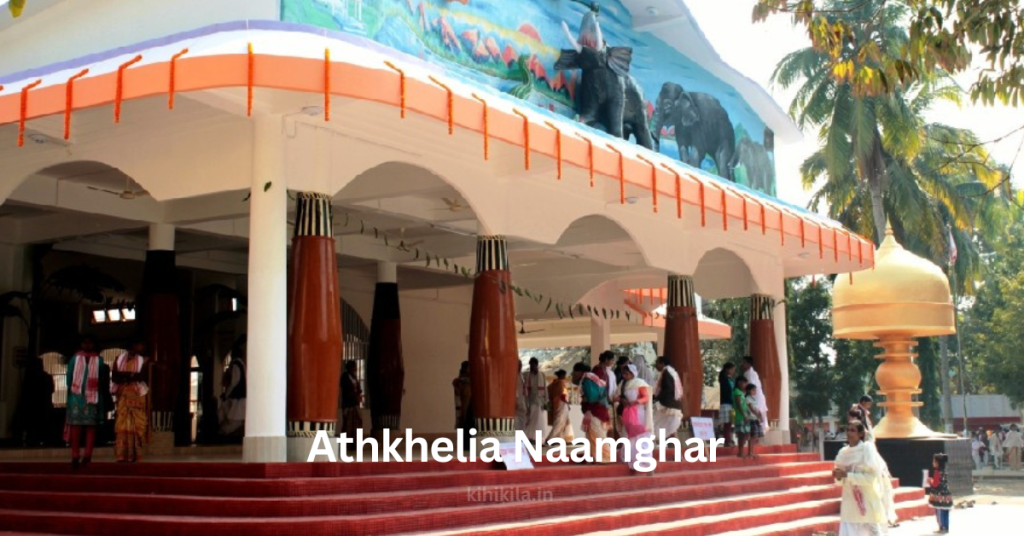A Place of Devotion and History
Athkhelia Naamghar holds a significant place in Assam’s cultural and spiritual history. Located about 20 km from Golaghat town, this revered place of worship was established around 1681 by Ahom King Gadadhar Singha, formerly known as Gadapani. The naamghar is not just a center for prayers but also a symbol of historical resilience and faith.
The Historical Significance
From 1670 to 1681, the Ahom kingdom was under the rule of Lora Roja, a tyrant who sought to eliminate any threat to his throne by crippling potential successors. To escape persecution, Prince Gadapani fled to the Naga Hills, where he found refuge in a hermitage at the location of the present-day Athkhelia Naamghar. The area was then a dense forest, inhabited by wild animals and a few families struggling to survive.

Legend says that as Lora Raja’s soldiers chased Gadapani, a miraculous event occurred. A thick cobweb suddenly covered the path he had taken, leading the soldiers to believe he had not passed that way, thus saving his life. Later, after ascending the throne in 1681 as Gadadhar Singha, he attempted to find the saint who had sheltered him but was unsuccessful. In gratitude, he entrusted the responsibility of maintaining the hermitage to the eight families residing there, forming the foundation of what is now known as Athkhelia Naamghar.
The Meaning Behind the Name
The name ‘Athkhelia’ has roots in the eight (‘aath’) different clans (‘kuri’ or ‘khel’) that played a role in managing the Naamghar. These clans include:
- Bochakuri: Served the king in various duties.
- Bairagikuri: Acted as royal messengers.
- Brahmankuri: Consisted of Brahmins brought in for religious rituals.
- Nangalkuri: Handled agricultural responsibilities.
- Solalkuri: Represented wise and knowledgeable individuals.
- Kacharikuri: Named after a person called Kachari.
- Borahikuri: Originated from the Borahi tribe, later converted to Vaishnavism.
- Kakatikuri: Managed land records and taxation.
Over time, these eight clans became integral to the administration of religious activities at Athkhelia Naamghar, and the name evolved from ‘Athkuria’ to ‘Athkhelia.’
Religious Importance and Festivals
Athkhelia Naamghar is a revered pilgrimage site, attracting thousands of devotees, especially during the holy month of Bhada. Devotees believe that prayers offered here bring blessings and fulfill wishes. Naam-kirtan (chanting prayers) is a daily ritual, and special offerings are made on behalf of the eight original clans before the prayers begin.
During Bhada, nearly 20 to 25 lakh devotees visit the Naamghar annually. To accommodate them, extensive arrangements are made, including guest houses and rest areas for those traveling from distant locations. Plans are underway to establish a cultural museum and a dedicated bus stand to facilitate better access for visitors.
Architectural and Cultural Development
Since 1900, the Athkhelia Naamghar Development Committee has played a crucial role in maintaining and upgrading the temple premises. Over the years, the committee has ensured the construction of essential facilities, including:
- A permanent Naamghar structure
- Electricity and water supply
- Guest houses and resting areas
- Concrete walls and a grand entrance
- Improved roads for better accessibility
These developments have made Athkhelia Naamghar not just a religious site but also a well-managed heritage location that preserves the essence of Assamese spirituality and devotion.
Why Athkhelia Naamghar is Special
Unlike many other Naamghars in Assam, Athkhelia Naamghar stands out due to its deep historical connections, miraculous legends, and its role in shaping the Ahom Dynasty’s legacy. It is not merely a place of worship but a historical testimony to the resilience, faith, and cultural unity of the eight founding clans.
With its serene surroundings, rich history, and spiritual importance, Athkhelia Naamghar continues to be a source of devotion and pride for Assamese people. Whether for religious purposes or historical curiosity, this sacred site remains an invaluable part of Assam’s cultural landscape.
A post shared by Ki Hikila?™️ | Knowledge in Assamese (@kihikila)
FAQ’s:
Where is Athkhelia Naamghar located?
Athkhelia Naamghar is situated in Bosa Gaon, approximately 18 to 20 kilometers from Golaghat town in Assam, India.
Who established Athkhelia Naamghar and when?
It was established around 1681 AD by Ahom King Gadadhar Singha, also known as Gadapani.
Why is it called ‘Athkhelia’?
The name ‘Athkhelia’ originates from the eight ‘khels’ or clans—Bochakuri, Bairagikuri, Brahmankuri, Nangalkuri, Solalkuri, Kacharikuri, Borahikuri, and Kakatikuri—who were entrusted with the maintenance of the Naamghar.
What is the significance of Athkhelia Naamghar?
It serves as a prominent pilgrimage site and holds deep cultural and spiritual importance in Assam’s history.
When do most devotees visit Athkhelia Naamghar?
The holy month of Bhada attracts nearly 2 to 2.5 million devotees annually.
What facilities are available for visitors?
Amenities include guest houses, rest areas, and plans for a cultural museum and dedicated bus stand to accommodate pilgrims.
How can one reach Athkhelia Naamghar?
It is accessible via road from Golaghat town, with improved connectivity and transportation facilities.
What architectural features does the Naamghar have?
The complex includes a permanent Naamghar structure, electricity and water supply, guest houses, concrete walls, and a grand entrance.
Are there any ongoing development projects?
Yes, developments include constructing a cultural museum, a bus stand, and enhancing facilities for devotees.
What makes Athkhelia Naamghar unique?
Its deep historical connections, miraculous legends, and role in shaping the Ahom Dynasty’s legacy make it a unique spiritual and cultural landmark.












